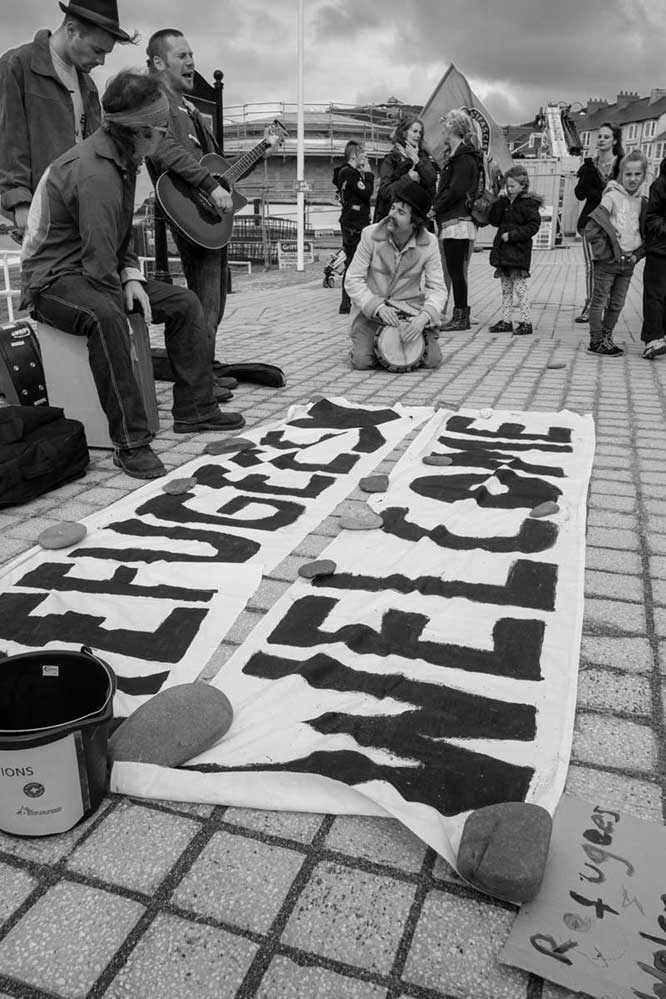Aberystwyth: Bubble or Sanctuary?
Wales and the Refugee Crisis 19.12.17


Our Aberystwyth University Student Ambassador Fraya Lee Reynolds gives a personal response
to an article in Planet on refugee history in Wales, drawing on her experience of
living in Aberystwyth during the current refugee crisis.

Refugee solidarity event in Aberystwyth, September 2015 © Simon Evans
There is one word that has been sprawled across the newspapers and has become embedded in our consciousness in 2017: 'refugee'. This word has become abstracted from its definition and sparks debates and discussion throughout Europe. Stories have been twisted and those who seek refuge have been demonised. Questions of 'when can we let them in?' have often turned to 'can we let them in?'. Hands are collectively thrown up in defeat with outcries of there being not enough space and not enough security checks. Seemingly, this rhetoric has won out, and the drawbridge is up. For many, myself included, this is simply not good enough. The UN Refugee Convention defines a refugee as someone who ‘owing to a well-founded fear of being persecuted for reasons of race, religion, nationality, membership of a particular social group, or political opinion, is outside the country of his nationality, and is unable to or, owing to such fear, is unwilling to avail himself of the protection of that country’. When we absorb an understanding of the definition of a refugee, with all its complexities, and the multifaceted experience of suffering and fear that refugees face, our compassion and humanity should then be triggered.
In Anne Lauppe-Dunbar's article ‘Following the Red Thread West’ in Planet 221, she explores her mother’s experience of fleeing the Soviet zone in Germany in 1947 and muses upon the role of her own home in Swansea as a shelter for refugees. These reflections are prompted by an art exhibition ‘EuroVisions: Wales Through the Eyes of European Visitors, 1750 – 2015’. What was so moving to me was the depiction of a couple in a painting in the exhibition (Visitors Ysbyty Gwynedd), their arms wrapped around each other, almost as if to say ‘you are safe now’. Their backs are turned away from us towards what we can only presume to be their home. While Anne makes it clear this painting depicts visitors to a hospital in Bangor, this work by Karel Lek, who fled here as a Jewish child refugee from Belgium, arguably evoke his experience, and suggests that humanity and hope can still survive a refugee crisis. Maybe this couple is weary from a hospital visit, maybe they have visited a loved one in the hospital. The message is clear: with an arm of support they walk onwards, head arched towards one another, a touching moment of support and intimacy. Why I wonder, is this not the prevailing attitude in the UK towards refugees? While the UK has aimed to settle 20,000 Syrian refugees by 2020, the approach seems to be less of extending an arm of support and more one of reluctance to help. Notions of home are undoubtedly important, when considering the issue of refugees in Wales, and Wales can often be a supportive sanctuary that shields those fleeing violence. A salve to the harsh conservatism of Westminster, Welsh people’s stoic resolve to lend a limited arm of support is evident in their actions. In a similar fashion to the feelings evoked by Anne's walk along Mumbles Bay, the atmosphere of comfort and safety felt along Aberystwyth seafront affects many. Anne's own family ties with refugee crises invoke a strong desire in her to want to anchor herself somewhere safe, with national ties long forgotten in the process of fleeing. Walking along the Aberystwyth seafront, it's hard not to feel at home. It's hard to imagine a better place for those fleeing violence and persecution.
As a student at the university here, Aberystwyth was a welcoming beacon of hope. While many of my peers and I joke about 'The Aber bubble', this safe community, seemingly separated from the rest of Wales and the UK, provides a much-needed 'bubble' from war. While I can't speak for the experience of the refugees in Aberystwyth, I can speak for the people welcoming them here, such as the community association Aberaid, their banners emblazoned with 'Welcome, Croeso', the English and Welsh words communicating values of hope in this bilingual town. This interesting intersection between expressions of strong Welsh national identity and those of welcoming people from outside creates a force of kindness that I haven't witnessed in any of my other hometowns. Aberystwyth, with its open beaches, rolling hills and secluded forests is seemingly the perfect 'bubble' to recuperate, the town replenishing each year with new students bringing new life and new experiences to the town. While I don't mean to paint the town in a saintly fashion, it is nevertheless a good example of Welsh hospitality and kindness, of which I hope much more have the opportunity to experience.
Clearly, Aberystwyth cannot house all of the refugees promised by the UK, but nevertheless this little town sets a compassionate precedent for all other towns to follow suit. Despite its small size, the welcome offered by Aberystwyth locals and students is evident, the secluded community lending warm support. Much like the painting in the art exhibition, visitors are noticed and welcomed with open arms.
About the author
Fraya Lee Reynolds is a third-year undergraduate at Aberystwyth University
If you liked this you may also like:
Kevin Hudson
Retracing Wales: Barry
Kathryn Morgan
Crossing Borders
Natalie Cox
Retracing Wales | Discover the Shape of a Nation
Greg Taylor
Reflections on 'Welsh Keywords'